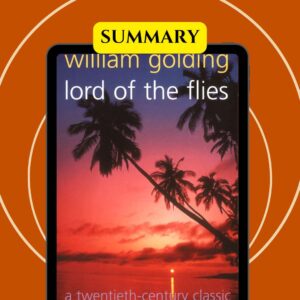Lord of the Flies book summary
Lord of the Flies by William Golding is a renowned classic novel that delves into the complexities of human nature and society. With its vivid storytelling and profound themes, the book has left a lasting impact on literature and readers worldwide.
Brief Overview
- Lord of the Flies follows a group of boys stranded on an uninhabited island, struggling to maintain order and survive.
- Published in 1954, the novel remains a staple in literary circles for its exploration of themes such as civilization, savagery, and the inherent darkness within humanity.

Table of Contents
Author Background
William Golding
- William Golding, an English author born in 1911, was known for his profound exploration of human nature in his works.
- His writing style is characterized by a blend of allegory and psychological depth, inviting readers to reflect on deeper truths about the human condition.
Plot Summary
Introduction
- The story begins with a group of British boys marooned on a remote island after a plane crash.
- Led by Ralph, the boys attempt to establish a civilized society based on rules and cooperation.
Main Characters
- Ralph: Represents leadership and order, striving to maintain civility amidst chaos.
- Piggy: Symbolizes reason and intellect, often marginalized by the other boys.
- Jack: Embodies savagery and primal instincts, leading a faction that opposes Ralph’s governance.
- Simon: A compassionate and introspective character, whose spiritual insights contrast with the group’s descent into savagery.
Chapter Summaries
Chapter 1: The Sound of the Shell
- Introduces Ralph and Piggy, who find a conch shell that becomes a symbol of authority.
Chapter 2: Fire on the Mountain
- The boys struggle to maintain a signal fire while conflicts arise between Ralph and Jack.
Chapter 3: Huts on the Beach
- Ralph focuses on building shelters, highlighting the divergence in priorities within the group.
Chapter 4: Painted Faces and Long Hair
- Jack becomes obsessed with hunting, symbolizing the shift towards savagery.
Chapter 5: Beast from Water
- Fear of a mysterious beast grows among the boys, mirroring their internal fears and darkness.
Chapter 6: Beast from Air
- Simon has a profound encounter with the Lord of the Flies, foreshadowing the escalating tensions on the island.
Chapter 7: Shadows and Tall Trees
- Conflict between Ralph’s group and Jack’s hunters intensifies, leading to a breakdown in cooperation.
Chapter 8: Gift for the Darkness
- The boys’ descent into savagery becomes more pronounced, culminating in a tragic event.
Chapter 9: A View to a Death
- Simon’s demise at the hands of the group highlights the brutal consequences of unchecked savagery.
Chapter 10: The Shell and the Glasses
- Ralph and Piggy face increasing hostility from Jack’s faction, emphasizing the erosion of order.
Chapter 11: Castle Rock
- Jack’s tribe captures Samneric, further solidifying his tyrannical rule over the island.
Chapter 12: Cry of the Hunters
- The pursuit of Ralph escalates into a frenzied hunt, illustrating the primal instincts that dominate the boys’ actions.
Character Analysis
Ralph
- Symbolizes democracy and order, embodying civilized values in the face of chaos.
Piggy
- Represents intellect and reason, serving as a voice of logic amidst the boys’ descent into savagery.
Jack
- Epitomizes savagery and primal impulses, leading a faction that challenges Ralph’s authority.
Simon
- Symbolizes spirituality and morality, offering profound insights into the darkness within each individual.
Key Themes
Civilization vs. Savagery
- The novel explores the delicate balance between societal order and the primal instincts that threaten to unravel it.
Loss of Innocence
- The boys’ gradual descent into savagery exposes the loss of innocence and the harsh realities of human nature.
Darkness Within Human Nature
- Golding’s narrative delves into the inherent darkness that resides within individuals, challenging notions of inherent goodness.
Symbolism and Allegory
The Conch Shell
- Symbolizes authority and order, serving as a beacon of civility amidst chaos.
The Beast
- Represents the boys’ inner fears and savagery, manifesting as a source of terror and paranoia.
The Lord of the Flies
- Symbolizes the inherent evil within human nature, challenging the characters and readers to confront their darkest impulses.
Cinematic Adaptations of Lord of the Flies (William Golding, Novel analysis)
- Several film adaptations have been made based on Golding’s classic novel.
- Each adaptation brings its unique perspective to the story, presenting different interpretations of the characters and themes.
Comparison of the Book and Film Adaptations (Symbolism in literature, Human nature themes)
- The book and film adaptations often differ in how they portray the characters and key events.
- The visual medium of film allows for a more immersive experience but can sometimes lose the depth and nuance of the novel.
- Analyzing these adaptations can offer insights into how different storytellers interpret and present the themes of the original work.
Significance and Legacy of Lord of the Flies (Psychological allegory, Survival instinct)
- The enduring significance of Lord of the Flies lies in its exploration of human nature and society.
- The novel’s portrayal of the inherent darkness within human nature and the struggle between civilization and savagery resonates with readers across generations.
- Its lessons on the fragility of societal structures and the primal instincts that drive human behavior continue to be relevant in contemporary society.
Impact on Literature and Pop Culture (Island setting, Coming of age story)
- Lord of the Flies has left a lasting impact on literature, influencing subsequent works that delve into similar themes.
- Its exploration of adolescent psychology and the complexities of group dynamics has become a recurring motif in coming-of-age stories.
- The isolated island setting serves as a potent backdrop for the characters’ transformation and the breakdown of societal norms.
Criticism and Controversies Surrounding Lord of the Flies (Literary criticism, Education curriculum)
- Despite its acclaim, Lord of the Flies has faced criticism and controversies over the years.
- Some critics argue that the novel oversimplifies the complexities of human nature and societal dynamics.
- Additionally, its inclusion in educational curricula has sparked debates about its appropriateness for certain age groups and the messaging it conveys.
Interpretations and Debates on Golding’s Work (Morality exploration, Psychological breakdown)
- Scholars and readers continue to offer varied interpretations of Golding’s work, leading to ongoing debates on its themes and messages.
- The novel’s provocative exploration of morality, power dynamics, and the human psyche invites critical analysis and diverse perspectives.
Frequently Asked Questions:
What is the main message of Lord of the Flies?
The main message of Lord of the Flies revolves around the inherent darkness within human nature, the conflict between civilization and savagery, and the loss of innocence.
How does the author, William Golding, use symbolism in the novel?
William Golding employs various symbols like the conch shell, the beast, and the Lord of the Flies to convey deeper meanings and explore themes such as power, fear, and the breakdown of societal norms.
Who are the main characters in Lord of the Flies and what are their roles?
The main characters in the novel include Ralph, Piggy, Jack, and Simon. Each character represents different aspects of human nature and plays a crucial role in the development of the story.
What are some key themes explored in Lord of the Flies?
Lord of the Flies delves into major themes such as the struggle between civilization and savagery, the loss of innocence, the presence of evil within individuals, and the consequences of unchecked power dynamics.
What is the significance of the title Lord of the Flies?
The title Lord of the Flies refers to the literal translation of the name Beelzebub, symbolizing the evil and darkness that reside within individuals and societies.
Conclusion:
In conclusion, Lord of the Flies by William Golding remains a timeless classic that continues to resonate with readers due to its profound exploration of human nature, society, and the complexities of morality. Through its vivid characters, gripping plot, and thought-provoking themes, the novel challenges readers to confront the darker aspects of humanity and reflects on the fragile balance between civilization and savagery. As a seminal work in literature, Lord of the Flies reminds us of the enduring power of storytelling to illuminate truths about the human condition and provoke introspection into our own natures.





